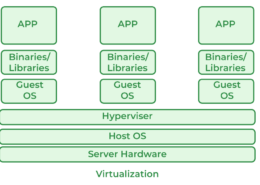Describe the three-schema architecture. why do we need mapping between schema levels?
Virtualization is a technology that creates virtual instances of physical hardware resources, such as servers, storage devices, and networks. It allows multiple virtual machines (VMs) to run on a single physical machine, each with its own operating system and applications. This is achieved through aRead more
Virtualization is a technology that creates virtual instances of physical hardware resources, such as servers, storage devices, and networks. It allows multiple virtual machines (VMs) to run on a single physical machine, each with its own operating system and applications. This is achieved through a software layer called a hypervisor, which manages and allocates resources to each VM.
- Key Concepts:
- Hypervisor: Software that enables multiple VMs to run on a single physical machine. Types include Type 1 (bare-metal) and Type 2 (hosted).
- Virtual Machines (VMs): Independent instances that run their own operating systems and applications, sharing the underlying physical hardware.
- Benefits in Cloud Computing:
Top 3 Benefits:
- Resource Efficiency: Virtualization maximizes the use of physical hardware by allowing multiple VMs to run on a single server, reducing the need for additional hardware.
- Cost Savings: Reduced hardware requirements lead to lower capital and operational expenses, including energy consumption and maintenance costs.
- Scalability: Virtualization allows for easy scaling of resources. New VMs can be quickly created to handle increased demand, and redundant VMs can be removed when demand decreases.
Other Benefits:
Isolation and Security, Enhanced Disaster Recovery, Business Continuity and Flexibility etc.
Virtualization is a cornerstone of cloud computing, enabling efficient, flexible, and cost-effective resource management.
See less

The three-schema architecture separates database definition into three levels: External Schema (Views): Customized views for different users. Conceptual Schema: Overall logical structure, independent of storage. Internal Schema: Physical storage details (invisible to users). Mappings connect these lRead more
The three-schema architecture separates database definition into three levels:
Mappings connect these levels:
This layered approach offers benefits:
- Data Independence: Changes to storage won’t affect user views.
- Security: Users only see authorized data.
- Flexibility: New user views can be added easily.
See less